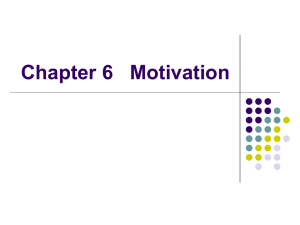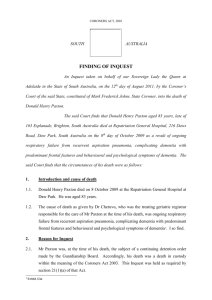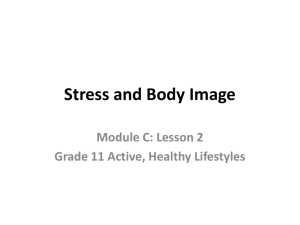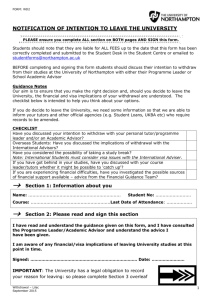Prevention, Early Intervention and Treatment of Body Image
advertisement
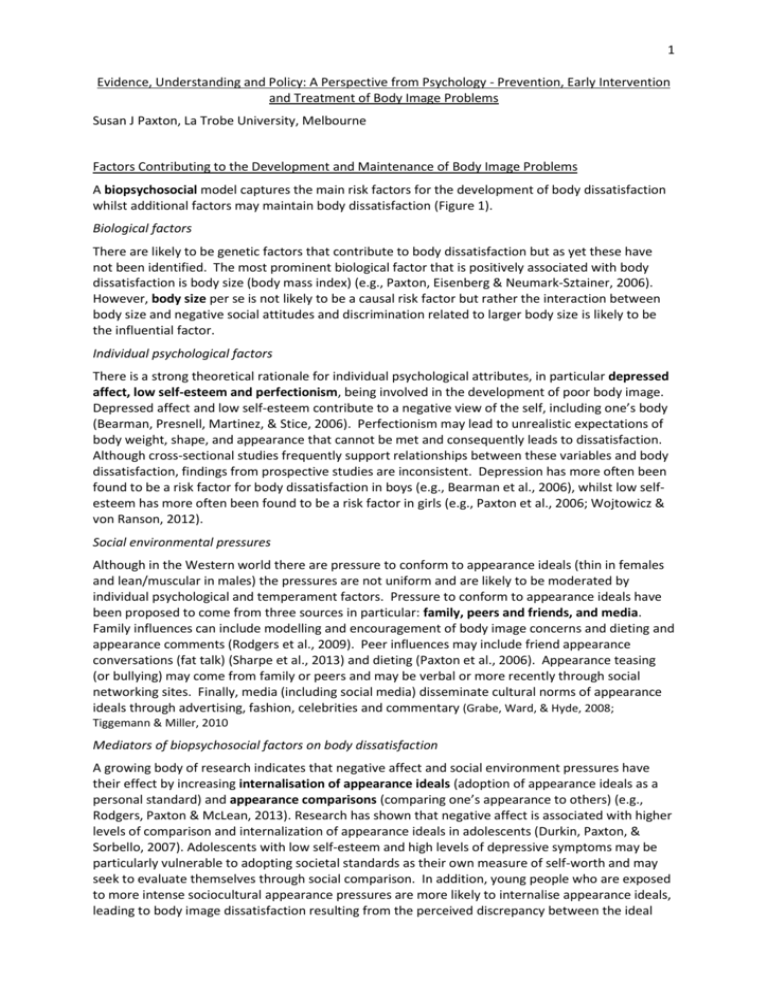
1 Evidence, Understanding and Policy: A Perspective from Psychology - Prevention, Early Intervention and Treatment of Body Image Problems Susan J Paxton, La Trobe University, Melbourne Factors Contributing to the Development and Maintenance of Body Image Problems A biopsychosocial model captures the main risk factors for the development of body dissatisfaction whilst additional factors may maintain body dissatisfaction (Figure 1). Biological factors There are likely to be genetic factors that contribute to body dissatisfaction but as yet these have not been identified. The most prominent biological factor that is positively associated with body dissatisfaction is body size (body mass index) (e.g., Paxton, Eisenberg & Neumark-Sztainer, 2006). However, body size per se is not likely to be a causal risk factor but rather the interaction between body size and negative social attitudes and discrimination related to larger body size is likely to be the influential factor. Individual psychological factors There is a strong theoretical rationale for individual psychological attributes, in particular depressed affect, low self-esteem and perfectionism, being involved in the development of poor body image. Depressed affect and low self-esteem contribute to a negative view of the self, including one’s body (Bearman, Presnell, Martinez, & Stice, 2006). Perfectionism may lead to unrealistic expectations of body weight, shape, and appearance that cannot be met and consequently leads to dissatisfaction. Although cross-sectional studies frequently support relationships between these variables and body dissatisfaction, findings from prospective studies are inconsistent. Depression has more often been found to be a risk factor for body dissatisfaction in boys (e.g., Bearman et al., 2006), whilst low selfesteem has more often been found to be a risk factor in girls (e.g., Paxton et al., 2006; Wojtowicz & von Ranson, 2012). Social environmental pressures Although in the Western world there are pressure to conform to appearance ideals (thin in females and lean/muscular in males) the pressures are not uniform and are likely to be moderated by individual psychological and temperament factors. Pressure to conform to appearance ideals have been proposed to come from three sources in particular: family, peers and friends, and media. Family influences can include modelling and encouragement of body image concerns and dieting and appearance comments (Rodgers et al., 2009). Peer influences may include friend appearance conversations (fat talk) (Sharpe et al., 2013) and dieting (Paxton et al., 2006). Appearance teasing (or bullying) may come from family or peers and may be verbal or more recently through social networking sites. Finally, media (including social media) disseminate cultural norms of appearance ideals through advertising, fashion, celebrities and commentary (Grabe, Ward, & Hyde, 2008; Tiggemann & Miller, 2010 Mediators of biopsychosocial factors on body dissatisfaction A growing body of research indicates that negative affect and social environment pressures have their effect by increasing internalisation of appearance ideals (adoption of appearance ideals as a personal standard) and appearance comparisons (comparing one’s appearance to others) (e.g., Rodgers, Paxton & McLean, 2013). Research has shown that negative affect is associated with higher levels of comparison and internalization of appearance ideals in adolescents (Durkin, Paxton, & Sorbello, 2007). Adolescents with low self-esteem and high levels of depressive symptoms may be particularly vulnerable to adopting societal standards as their own measure of self-worth and may seek to evaluate themselves through social comparison. In addition, young people who are exposed to more intense sociocultural appearance pressures are more likely to internalise appearance ideals, leading to body image dissatisfaction resulting from the perceived discrepancy between the ideal 2 and their own personal physical appearance (Thompson & Stice 2001). This process is facilitated by comparison of one’s body with others, including with peers or media, which heightens the perception of the discrepancy between the self and the ideal (Schutz et al., 2002). Maintaining factors In addition to continuation of the risk factors which also maintain body dissatisfaction, body checking (e.g., frequent weighing or checking particular body parts) and body avoidance (e.g., avoiding mirrors) are behaviours which focus attention on disliked aspects of the body and consequently maintain body dissatisfaction (Paxton & McLean, 2009). Effective Interventions Influences on body image are many, have different impacts at different life stages, and are continually evolving. Consequently, no one intervention is likely to prevent or eliminate body dissatisfaction in all participants. However, there are a number of interventions that target different groups that appear promising. In addition, interventions may be delivered at different stages of the development of body image problems. Points of Intervention: Prevention, Early Intervention and Treatment Interventions may target young people, ideally before the development of body image problems, and be delivered to groups independent of whether risk factors are present or not (i.e., universal or selective prevention). These include class-room based interventions and usually include young adolescents. Interventions have also been developed for late adolescents and young adults who already have developed body image problems (i.e., indicated prevention). Typically, the goal of prevention and early intervention is to reduce the presence of risk factors (e.g., environmental appearance pressures, internalisation and body comparison) thereby reducing body dissatisfaction. Interventions also include therapy for individuals with body image problems that are interfering with their lives and often occur in the context of disordered eating. Intervention Strategies Changing environments: Potential environments that could be influenced to provide a more positive body image environment include media/fashion environments (e.g., internet and magazine advertising, celebrity commentary); family environments (e.g., providing effective resources for parents); and peer environments (e.g., whole school and class-room interventions). These changes need to happen at all level but will be incremental – most likely no one intervention will eliminate body image problems. At present their impact is hard to measure. Providing skills and knowledge to cope with environments and challenge personal values: This is the most promising approach at present. Valuable skills appear to be media literacy (ability to analyse, interpret and evaluate media), reducing appearance conversations/fat talk, ability to challenging attitudes and environmental pressures, and reducing body comparison. School class-room based interventions (grade 6-8) that have used combinations of these strategies have so far shown the most promise in reducing risk factors and body dissatisfaction. These include Media Smart (Wilksch & Wade, 2009), Happy Being Me (Bird, Halliwell, Diedrichs & Harrcourt, 2013; Richardson & Paxton, 2010), and Me, You & Us (Sharpe, Schober, Treasure & Schmidt, in press). In addition, interventions for older adolescent and young adult women who identify themselves as having body image problems (indicated prevention) have been shown to respond to small group intervention using techniques that help participants challenge the thin ideal – notably cognitive dissonance approaches (e.g, Stice et al., 2008). 3 Therapy: Therapy for body image problems conducted in small groups, usually but not always in the context of disordered eating, has been shown to be effective for adolescent girls, young women and women in midlife (e.g., Paxton, McLean, Gollings, Faulkner, & Wertheim, 2007). Public Policy and Body Image There are a range of positive actions that governments can take. They include leadership in conveying the importance of body image issues as well as providing practical support for the implementation and dissemination of effective interventions across the prevention-therapy spectrum. Leadership Governments can highlight the importance of body image issues and thereby provide ammunition for others in different sectors to address the issue. For example, promoting voluntary codes of conducted such as the Voluntary Québec Charter for a Healthy and Diverse Body Image launched in Québec in 2009 (Gauvin & Steiger, 2012) and the Voluntary Industry Code of Conduct on Body Image (Australian Government, 2009). It is valuable to build on initiatives of this kind with activities that reward positive industry behaviour such as the Body Confidence Awards in the UK and the Positive Body Image Awards in Australia. Governments can frequently influence education (depending on the political structures). In Australia, the Revised Australian Curriculum: Health and Physical Education: Foundation to Year 10 (Australian Curriculum, Assessment and Reporting Authority, 2013) has specifically included body image as a topic in the curriculum and supported the development of media literacy teaching resources in the context of body image. Governments can also take legislative action which is more relevant in some environments than others. For example, in Israel models cannot be used if they have a body mass index less than 18.5. Practical Support Resources can be used to support implementation and dissemination of interventions. In educational setting, for example, evidence-based materials can be placed on the internet and advertised through different channels and support can be provided for teacher training. There are a range of evaluated interventions described above, incorporating media literacy and peer interventions that could be supported. Although reach was not evaluated, advertising (social marketing) on social networking sites has also been used to raise media literacy of young people (Paxton, 2011). The European Commission is currently financing the development and evaluation of ProYouth, an internet delivered interactive prevention and early intervention program for body image and eating disorders (Bauer & Moessner, 2013). Evaluation is in its early stages but an earlier related program showed some positive effects. Across all these areas, support can also be provided for research and evaluation of interventions to ensure appropriate use of public resources. References Australian Government. (2009). Voluntary industry code of conduct on body image. Retrieved from http://www.youth.gov.au/sites/Youth/bodyImage/codeofconduct Australian Curriculum, Assessment and Reporting Authority (2013). Revised Australian Curriculum: Health and Physical Education: Foundation to Year 10. Bauer, S., & Moessner, M. (2013). Harnessing the power of technology for the treatment and prevention of eating disorders. International Journal of Eating Disorders, 46, 508-515. 4 Bearman, S. K., Presnell, K., Martinez, E., & Stice, E. (2006). The skinny on body dissatisfaction: A longitudinal study of adolescent girls and boys. Journal of Youth and Adolescence, 35, 229-241. Bird, E. L., Halliwell, E., Diedrichs, P. C., & Harcourt, D. (2013). Happy Being Me in the UK: A controlled evaluation of a school-based body image intervention with pre-adolescent children. Body Image, 10(3), 326-334. Durkin, S. J., Paxton, S. J. & Sorbello, M. (2007). An integrative model of the impact of exposure to idealized female images on adolescent girls' body satisfaction. Journal of Applied Social Psychology, 37, 1092-1117. Gauvin, L., & Steiger, H. (2012). Overcoming the unhealthy pursuit of thinness: Reaction to the Québec Charter for a Healthy and Diverse Body Image. American Journal of Public Health, 102, 1600-1606. Grabe, S., Ward, L. M., & Hyde, J. S. (2008). The role of the media in body image concerns among women: A meta-analysis of experimental and correlational studies. Psychological Bulletin, 134(3), 460-476. Richardson, S. M., & Paxton, S. J. (2010). An evaluation of a body image intervention based on risk factors for body dissatisfaction: A controlled study with adolescent girls. International Journal of Eating Disorders, 43(2), 112-122. Rodgers, R. F., Paxton, S. J., & Chabrol, H. (2009). Effects of parental comments on body dissatisfaction and eating disturbance in young adults: A sociocultural model. Body Image, 6(3), 171–177. Rodgers, R.F., Paxton, S.J., Mclean, S.A. (2013). A biopsychosocial model of body image concerns and disordered eating in early adolescent girls. Journal of Youth and Adolescence. doi: 10.1007/s10964-013-0013-7 Paxton, S. J. (2011). Public policy and prevention. In T. Cash & L. Smolak (Eds), Body image: A handbook of science, practice and prevention (2nd ed., pp. 460-468). New York: Guilford Press. Paxton, S. J., Eisenberg, M. E., & Neumark-Sztainer, D. (2006). Prospective predictors of body dissatisfaction in adolescent girls and boys: A five-year longitudinal study. Developmental Psychology, 42(5), 888–899. Paxton, S. J. McLean, S. A. Gollings, E. K., Faulkner, C. & Wertheim, E. H. (2007). Comparison of faceto-face and internet interventions for body image and eating problems in adult women: an RCT. International Journal of Eating Disorders, 40, 692-704. Paxton, S.J. & McLean, S. (2009). Body image treatment. In C. Grilo & J. Mitchell (Eds). The treatment of eating disorders. New York: The Guilford Press, Ch 28, pp. 471-486. Schutz, H. K., Paxton, S. J., & Wertheim, E. H. (2002). Investigation of body comparison among adolescent girls. Journal of Applied Social Psychology, 32(9), 1906-1937. Sharpe, H., Naumann, U., Treasure, J., & Schmidt, U. (2013). Is fat talking a causal risk factor for body dissatisfaction? A systematic review and meta-analysis. International Journal of Eating Disorders, DOI: 10.1002/eat.22151 Stice, E., Marti, N., Spoor, S. Presnell, K., & Shaw, H. (2008). Dissonance and healthy weight eating disorder prevention programs: Long-term effects from a randomised efficacy trial. Journal of Consulting and Clinical Psychology, 76, 329-340. Thompson, J. K., & Stice, E. (2001). Thin-ideal internalization: Mounting evidence for a new risk factor for body-image disturbance and eating pathology. Current Directions in Psychological Science, 10(5), 181-183. Tiggemann, M., & Miller, J. (2010). The internet and adolescent girls’ weight satisfaction and drive for thinness. Sex Roles, 63(1), 79-90. Wilksch, S. M., & Wade, T. D. (2009). Reduction of shape and weight concern in young adolescents: A 30-month controlled evaluation of a media literacy program. Journal of the American Academy of Child & Adolescent Psychiatry, 48(6), 652-661. Wojtowicz, A. E., & von Ranson, K. M. (2012). Weighing in on risk factors for body dissatisfaction: A one-year prospective study of middle-adolescent girls. Body Image, 9, 20-30. 5 Figure 1: Biopsychosocial model of risk factors for the development of body dissatisfaction

